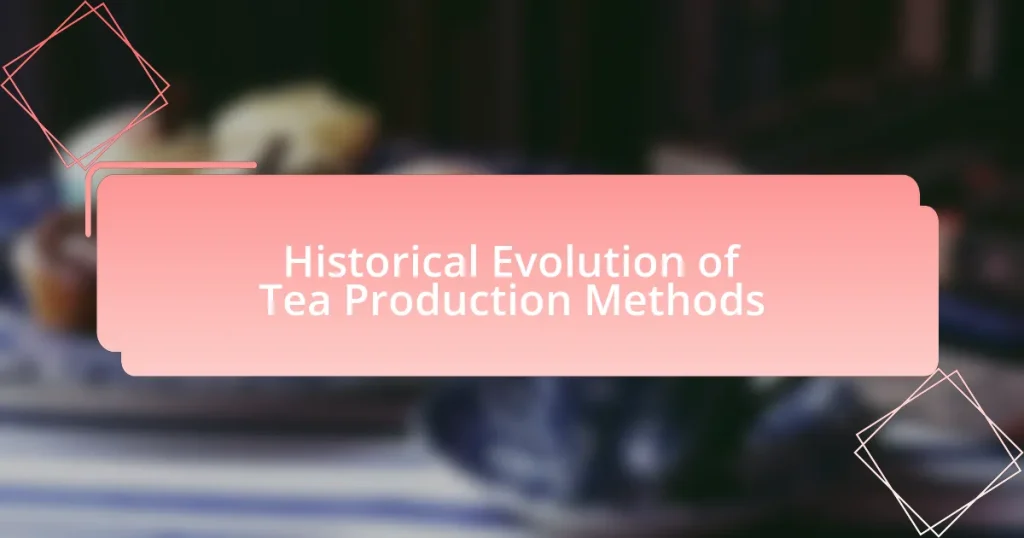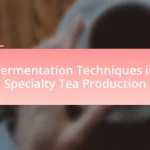The article examines the historical evolution of tea production methods, tracing its origins to ancient China around 2737 BCE, where tea was initially used as a medicinal beverage. It highlights key developments through various dynasties, including the refinement of processing techniques during the Tang and Song Dynasties, the introduction of black tea in the Ming Dynasty, and the impact of colonialism and mechanization in the 19th century. The article also discusses how geography, trade routes, and cultural influences shaped tea production, as well as current trends towards sustainability and technological advancements in the industry. Additionally, it addresses the challenges faced by tea producers today, including climate change and economic fluctuations, while outlining best practices for balancing quality and sustainability in modern tea production.

What is the Historical Evolution of Tea Production Methods?
The historical evolution of tea production methods began in ancient China around 2737 BCE, where the first documented use of tea leaves for brewing was recorded. Initially, tea was consumed as a medicinal beverage, and the methods involved simple hand-picking and sun-drying of leaves. By the Tang Dynasty (618-907 CE), the production process became more refined, with steaming and pan-firing techniques introduced to enhance flavor and preserve freshness.
During the Song Dynasty (960-1279 CE), the production of powdered tea became popular, leading to the development of the whisking method, which was a precursor to modern matcha preparation. The Ming Dynasty (1368-1644 CE) marked a significant shift as loose leaf tea gained prominence, and the method of oxidation was discovered, leading to the creation of black tea.
In the 19th century, the introduction of mechanical processing methods, such as rolling and drying machines, revolutionized tea production, increasing efficiency and consistency. The British colonial expansion further spread tea cultivation to regions like India and Sri Lanka, where unique production methods emerged, including the CTC (Crush, Tear, Curl) method for producing tea bags.
Today, tea production methods continue to evolve, incorporating technology while maintaining traditional practices, reflecting a blend of historical techniques and modern innovations.
How did tea production methods originate?
Tea production methods originated in ancient China, where the practice of cultivating and processing tea began around 2737 BCE, attributed to Emperor Shen Nong. The initial methods involved simple techniques of steaming and drying leaves to create a beverage. Over centuries, these methods evolved, influenced by regional practices and innovations, leading to diverse techniques such as pan-firing and oxidation. Historical records, including texts from the Tang Dynasty (618-907 CE), document the refinement of these methods, showcasing the transition from basic preparation to more sophisticated processes that define modern tea production.
What are the earliest known methods of tea production?
The earliest known methods of tea production involved simple processes of plucking, withering, and pan-firing or steaming the leaves. Historical records indicate that these methods were practiced in China as early as the Tang Dynasty (618-907 AD). During this period, tea leaves were hand-picked, then allowed to wither to reduce moisture content, followed by pan-firing to halt oxidation and preserve flavor. This foundational technique laid the groundwork for the diverse tea production methods that evolved over centuries, as evidenced by ancient texts and archaeological findings that document the cultivation and processing of tea in early Chinese society.
How did geography influence the development of tea production?
Geography significantly influenced the development of tea production by determining the climate, soil types, and elevation suitable for tea cultivation. Regions such as China, India, and Sri Lanka, characterized by specific climatic conditions like monsoon rains and temperate zones, provided ideal environments for growing Camellia sinensis, the tea plant. For instance, the mountainous regions of Assam and Darjeeling in India, with their rich, well-drained soils and high altitudes, are known for producing distinct varieties of tea, such as Assam and Darjeeling teas, which are highly valued globally. Additionally, the geographical distribution of these regions facilitated trade routes, allowing tea to spread from its origins in East Asia to other parts of the world, further enhancing its production and cultural significance.
What major historical milestones have shaped tea production?
The major historical milestones that have shaped tea production include the discovery of tea in China around 2737 BCE, the establishment of tea cultivation during the Tang Dynasty (618-907 CE), and the introduction of tea to Europe in the 16th century. The discovery of tea is attributed to Emperor Shen Nong, who is said to have accidentally brewed tea when leaves from a wild tree fell into his boiling water. During the Tang Dynasty, tea became a popular beverage, leading to the development of cultivation techniques and trade routes. The introduction of tea to Europe began with Portuguese and Dutch traders, which significantly increased its popularity and demand, ultimately leading to the establishment of tea plantations in British colonies in the 18th century. These milestones collectively transformed tea from a local Chinese beverage into a global commodity, influencing agricultural practices and trade networks worldwide.
What role did trade routes play in the evolution of tea production?
Trade routes significantly influenced the evolution of tea production by facilitating the exchange of knowledge, techniques, and resources across regions. The Silk Road, for instance, connected China with Central Asia and beyond, allowing for the transfer of tea cultivation methods and the introduction of new varieties. This exchange not only expanded the geographical reach of tea production but also led to innovations in processing techniques, such as the development of different fermentation methods that enhanced flavor profiles. Historical records indicate that by the 17th century, trade routes established by European powers further popularized tea in the West, leading to increased demand and the establishment of plantations in regions like India and Sri Lanka, which transformed global tea production dynamics.
How did colonialism impact tea production methods?
Colonialism significantly transformed tea production methods by introducing large-scale plantation systems and mechanization. European powers, particularly the British in India and Sri Lanka, established extensive tea plantations that replaced traditional farming practices. This shift led to the adoption of monoculture, where a single crop was cultivated extensively, increasing efficiency but reducing biodiversity. Additionally, colonialism facilitated the introduction of new technologies, such as steam-powered machinery for processing tea, which enhanced production speed and volume. Historical records indicate that by the late 19th century, India became one of the largest tea producers globally, largely due to these colonial practices, which prioritized profit over local agricultural traditions.
What are the key innovations in tea production over time?
Key innovations in tea production over time include the development of mechanized processing techniques, advancements in cultivation practices, and the introduction of new varieties. Mechanization, such as the use of tea plucking machines in the 20th century, significantly increased efficiency and reduced labor costs. Improved cultivation practices, including the use of fertilizers and pest management strategies, have enhanced yield and quality. Additionally, the introduction of hybrid tea plants has led to greater disease resistance and adaptability to various climates, further optimizing production. These innovations have collectively transformed tea production into a more efficient and sustainable industry.
How did technological advancements change tea processing?
Technological advancements significantly transformed tea processing by introducing mechanization and automation, which increased efficiency and consistency. For instance, the development of machines for withering, rolling, and drying tea leaves allowed for faster processing times compared to traditional hand methods. The introduction of the CTC (Crush, Tear, Curl) method in the 1930s revolutionized black tea production by enabling the rapid production of small, uniform tea particles, which enhanced flavor extraction during brewing. Additionally, advancements in temperature control and humidity regulation during drying processes improved the preservation of flavor and aroma, leading to higher quality tea products. These innovations collectively contributed to the scalability of tea production and the ability to meet growing global demand.
What modern techniques have emerged in tea cultivation?
Modern techniques in tea cultivation include precision agriculture, which utilizes data analytics and technology to optimize growth conditions, and integrated pest management (IPM), which combines biological control with minimal chemical use to protect crops. Precision agriculture employs tools such as drones and soil sensors to monitor plant health and soil moisture, leading to improved yields and resource efficiency. IPM strategies have been shown to reduce pesticide use by up to 50%, promoting environmental sustainability while maintaining crop quality. These advancements reflect a shift towards more sustainable and efficient practices in the tea industry.

How have cultural influences affected tea production methods?
Cultural influences have significantly shaped tea production methods by introducing diverse practices and techniques that reflect regional traditions and preferences. For instance, in China, the cultural emphasis on tea as a symbol of hospitality has led to meticulous hand-picking and processing methods, such as the traditional artisanal approach used in the production of high-quality green teas like Longjing. In contrast, Japanese culture has influenced the production of matcha, where tea leaves are shade-grown and stone-ground, emphasizing a ceremonial aspect that highlights the aesthetic and meditative qualities of tea preparation. Additionally, British colonial influence introduced mass production techniques in India, leading to the establishment of large tea estates that prioritize efficiency over traditional methods. These cultural adaptations demonstrate how local customs, rituals, and historical contexts have directly impacted the evolution of tea production practices across different regions.
What cultural practices are associated with tea production?
Cultural practices associated with tea production include traditional harvesting techniques, rituals surrounding tea preparation and consumption, and regional festivals celebrating tea. In countries like China and Japan, specific methods such as hand-picking leaves and using unique tools reflect deep-rooted customs. For instance, the Japanese tea ceremony emphasizes aesthetics and mindfulness, showcasing the cultural significance of tea beyond mere consumption. Additionally, festivals like the Darjeeling Tea Festival in India highlight the community’s connection to tea cultivation, celebrating its economic and cultural importance. These practices illustrate how tea production is intertwined with local identities and heritage.
How do different cultures approach tea harvesting and processing?
Different cultures approach tea harvesting and processing through unique methods that reflect their traditions and environmental conditions. In China, for instance, tea is often hand-picked, with specific leaves selected based on the desired tea type, such as green or oolong, emphasizing quality and craftsmanship. In contrast, India employs both hand-picking and mechanical harvesting, particularly in large estates, to increase efficiency and yield, especially for Assam and Darjeeling teas. Japan focuses on meticulous processing techniques, such as steaming for green tea, which preserves the leaves’ vibrant color and fresh flavor. Each culture’s approach is influenced by historical practices, regional climate, and consumer preferences, showcasing the diversity in tea production methods globally.
What rituals and traditions have evolved around tea production?
Rituals and traditions surrounding tea production include the Japanese tea ceremony, known as Chanoyu, which emphasizes harmony, respect, purity, and tranquility in the preparation and consumption of matcha. This ceremony has historical roots dating back to the 12th century and reflects the cultural significance of tea in Japan. In China, the Gongfu tea ceremony showcases the skillful brewing of tea, highlighting the importance of the tea leaves’ quality and the brewing process, which has been practiced for centuries. Additionally, in many cultures, tea production involves seasonal festivals that celebrate the harvest, such as the Darjeeling Tea Festival in India, which honors the tea-growing community and promotes local culture. These rituals and traditions not only enhance the experience of tea but also preserve the cultural heritage associated with tea production.
How has globalization impacted tea production methods?
Globalization has significantly transformed tea production methods by introducing advanced agricultural techniques and expanding market access. The integration of global supply chains has led to the adoption of mechanization and improved processing technologies, enhancing efficiency and quality. For instance, countries like India and China have incorporated modern practices such as precision agriculture and automated processing, which have increased yield and reduced labor costs. Additionally, globalization has facilitated the exchange of knowledge and best practices among tea-producing nations, leading to innovations in cultivation and sustainability measures. This shift is evidenced by the rise of organic tea production, which caters to international demand for environmentally friendly products, reflecting changing consumer preferences influenced by global market trends.
What are the effects of international demand on tea production practices?
International demand significantly influences tea production practices by driving changes in cultivation methods, processing techniques, and quality standards. As global consumption of tea increases, producers adapt by implementing more efficient agricultural practices, such as the use of advanced irrigation systems and fertilizers, to enhance yield and meet market needs. For instance, countries like China and India have adopted mechanization in harvesting to boost productivity and reduce labor costs, responding to the rising demand from international markets. Additionally, international buyers often impose strict quality requirements, prompting producers to adopt better processing methods to ensure consistency and meet export standards. This shift has been documented in studies showing that countries exporting tea have improved their practices to align with global preferences, thereby increasing competitiveness in the international market.
How have global trade agreements influenced tea production methods?
Global trade agreements have significantly influenced tea production methods by promoting standardization and enhancing market access for producers. These agreements often include provisions that encourage the adoption of modern agricultural practices and technologies, which can lead to increased efficiency and higher quality tea. For instance, the World Trade Organization’s Trade-Related Aspects of Intellectual Property Rights (TRIPS) agreement has incentivized the use of patented technologies in tea cultivation, resulting in improved pest management and higher yield varieties. Additionally, trade agreements facilitate the exchange of knowledge and best practices among countries, allowing tea producers to adopt sustainable practices that meet international quality standards. This shift towards more efficient and sustainable production methods is evidenced by the rise of certified organic and fair-trade tea, which have gained popularity in global markets due to trade agreements that support ethical sourcing and environmental sustainability.

What are the current trends in tea production methods?
Current trends in tea production methods include the adoption of sustainable practices, increased automation, and the use of technology for precision agriculture. Sustainable practices, such as organic farming and agroforestry, are gaining traction as consumers demand environmentally friendly products. Automation in processing and packaging enhances efficiency and reduces labor costs, while technology like drones and sensors allows for better monitoring of crop health and soil conditions. These trends reflect a shift towards more efficient, eco-conscious, and technologically advanced methods in the tea industry.
What sustainable practices are being adopted in tea production today?
Sustainable practices in tea production today include organic farming, agroforestry, and water conservation techniques. Organic farming eliminates synthetic pesticides and fertilizers, promoting soil health and biodiversity. Agroforestry integrates tea cultivation with tree planting, enhancing ecosystem services and carbon sequestration. Water conservation techniques, such as drip irrigation and rainwater harvesting, reduce water usage and improve efficiency. These practices are supported by research indicating that organic tea farming can increase soil organic matter by up to 30%, while agroforestry systems can enhance biodiversity by providing habitats for various species.
How do organic farming methods affect tea quality and production?
Organic farming methods enhance tea quality and production by promoting healthier soil and reducing chemical residues. These methods, which include the use of natural fertilizers and pest control, lead to higher levels of antioxidants and essential oils in tea leaves, resulting in better flavor and aroma. Research indicates that organic tea can contain up to 30% more polyphenols, which are beneficial for health, compared to conventionally grown tea. Additionally, organic practices improve biodiversity and soil health, contributing to sustainable production systems that can yield high-quality tea over time.
What innovations are being implemented to improve efficiency in tea production?
Innovations in tea production aimed at improving efficiency include the use of precision agriculture technologies, automated harvesting systems, and advanced processing techniques. Precision agriculture utilizes data analytics and IoT devices to monitor soil health and optimize irrigation, leading to increased yield and reduced resource waste. Automated harvesting systems, such as robotic tea pickers, enhance labor efficiency and minimize damage to the leaves, while advanced processing techniques, including temperature-controlled withering and fermentation, improve the quality and consistency of the final product. These innovations collectively contribute to a more sustainable and efficient tea production process, as evidenced by studies showing that precision agriculture can increase crop yields by up to 20% while reducing water usage by 30%.
What challenges does the tea production industry face today?
The tea production industry faces significant challenges today, including climate change, labor shortages, and market fluctuations. Climate change affects tea yields and quality due to altered rainfall patterns and increased temperatures, with studies indicating that global warming could reduce suitable tea-growing areas by up to 50% by 2050. Labor shortages arise from an aging workforce and migration of younger workers to urban areas, leading to decreased productivity and increased costs. Additionally, market fluctuations driven by changing consumer preferences and economic conditions create instability, impacting pricing and profitability for producers.
How do climate change and environmental factors impact tea cultivation?
Climate change and environmental factors significantly impact tea cultivation by altering temperature, precipitation patterns, and increasing the frequency of extreme weather events. These changes can lead to reduced yields, altered growth cycles, and increased susceptibility to pests and diseases. For instance, studies indicate that a 1°C rise in temperature can decrease tea yields by up to 10%, while erratic rainfall can disrupt the delicate balance of moisture required for optimal growth. Additionally, increased carbon dioxide levels may initially boost growth but can also lead to lower quality tea due to changes in chemical composition.
What economic challenges are affecting tea producers globally?
Tea producers globally face several economic challenges, including fluctuating prices, climate change impacts, and labor shortages. Fluctuating prices are driven by market demand and supply dynamics, which can lead to instability in income for producers. For instance, the global tea market has seen price volatility, with prices dropping significantly in recent years, affecting the profitability of many tea estates. Climate change poses a significant threat, as changing weather patterns can disrupt traditional growing conditions, leading to reduced yields. Additionally, labor shortages, exacerbated by migration trends and changing workforce demographics, hinder production capacity and increase operational costs. These challenges collectively impact the sustainability and economic viability of tea production worldwide.
What best practices can be adopted for modern tea production?
Best practices for modern tea production include implementing sustainable farming techniques, utilizing precision agriculture, and adopting integrated pest management. Sustainable farming techniques, such as organic cultivation and agroforestry, enhance soil health and biodiversity, which are crucial for long-term productivity. Precision agriculture, which employs technology like drones and soil sensors, allows for efficient resource use and improved crop yields. Integrated pest management reduces chemical pesticide reliance by combining biological control, cultural practices, and resistant varieties, leading to healthier ecosystems. These practices are supported by research indicating that sustainable methods can increase tea quality and profitability while minimizing environmental impact.
How can producers balance quality and sustainability in tea production?
Producers can balance quality and sustainability in tea production by implementing organic farming practices and utilizing agroforestry systems. Organic farming enhances soil health and biodiversity, which leads to higher quality tea while reducing chemical inputs that harm the environment. Agroforestry systems, which integrate tea cultivation with tree planting, improve ecosystem services and provide shade, thus enhancing the flavor profile of the tea. Research indicates that organic tea can have higher antioxidant levels, contributing to both quality and health benefits, as shown in studies published in the Journal of Agricultural and Food Chemistry.
What strategies can enhance the marketability of tea products?
To enhance the marketability of tea products, companies should focus on branding, quality differentiation, and sustainable practices. Effective branding creates a strong identity that resonates with consumers, while quality differentiation ensures that products stand out in a crowded market. For instance, premium teas can be marketed based on unique flavor profiles or health benefits, appealing to health-conscious consumers. Additionally, adopting sustainable practices, such as organic farming and eco-friendly packaging, can attract environmentally aware customers. Research indicates that 66% of consumers are willing to pay more for sustainable brands, highlighting the importance of these strategies in increasing marketability.


